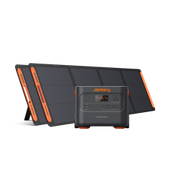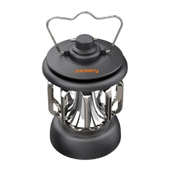Jackery is the global leader in manufacturing a wide range of innovative portable power stations and solar generators to charge home and outdoor appliances. The company is fully committed to building cutting-edge power solutions for outdoor enthusiasts and homeowners.
Both Jackery Explorer 300 and Jackery Explorer 500 have been in the power station space for a long time, catering to the needs of outdoor enthusiasts. These small, compact, and lightweight power stations are ideal for charging small appliances like cameras, laptops, phones, and more for short periods of time.
The Jackery Explorer 300 Plus is the upgraded version of the Jackery Explorer 300 that weighs only 8.27 lbs and can charge small appliances, such as phones, laptops, lights, TVs, projectors, etc. It features a foldable handle that ensures easy movement from one place to another.
This Jackery 300 vs. 500 comparison guide will compare two entry-level power stations in detail so you can choose the one that best fits your power needs.
Comparison Chart of Jackery Explorer 300 and 500
Jackery Explorer 300 and Explorer 500 are well-built power stations with decent designs. They have a solid build, an informative LCD display, a sleek and compact design, and well-thought-out updated multifunctional ports.

The Jackery Explorer 300 Plus is the upgraded version that features a LiFePO4 battery with long life cycles. It has a foldable, sturdy handle that ensures easy handling to outdoor locations.
The power stations are compatible with Jackery SolarSaga Solar Panels, so you can quickly recharge them and charge appliances on the go. The reliable and clean power source is an excellent choice for campers, RVs, hiking, and more.
In the following sections, we'll compare the features, specs, solar generator bundles, and recharging time of both power stations.
Features/Specs Comparison
Before we dig deep into the use cases of both the power stations, here is a quick breakdown of the main features.
|
Comparison |
Explorer 300 Plus |
||
|
Weight |
7.1 lbs (3.2 kg) |
8.27lbs (3.75kg) |
13.3lbs (6 kg) |
|
Portability |
Easy to carry handle |
Foldable handle |
Easy to carry handle |
|
Size (LxWx H) |
Height: 7.8 in (19.9 cm) Width: 5.2 in (13.3 cm) Length: 9.1 in (23 cm) |
Height: 6.6in (16.7cm) Width: 6.1in (15.5cm) Length: 9.1in (23cm) |
Height: 9.5 in (24.2 cm) Width: 7.6 in (19.2 cm) Length: 11.8 in (30 cm) |
|
Capacity |
293Wh |
288Wh |
518Wh |
|
Capacity Expandable |
No |
No |
No |
|
Output Power(Rated/Surge) |
300W (500W Peak) |
300W (600W Peak) |
500W (1000W Peak) |
|
AC Output |
(x2): 110V, 60Hz, 300W (500W Peak) |
(x1): 120V, 60Hz, 300W (600W Peak) |
(x1): 110V, 60Hz, 500W (1000W Peak) |
|
DC Output |
— |
— |
(x2): 12V⎓7A |
|
USB-A Output |
(x1): 5V⎓2.4A Quick Charge 3.0 (x1), 18W Max |
(x1): 15W Max 5V⎓3A |
(x3): 5V⎓2.4A |
|
USB-C Output |
(x1): 60W Max, (5V, 9V, 12V up to 3A) |
(x1): 15W Max 5V⎓3A |
— |
|
Car Port |
12V⎓10A |
12V⎓10A |
12V⎓10A |
|
DC Input |
24V⎓3.75A |
12-27V⎓5A, Max, 100W Max |
24V⎓3.75A |
|
Cell Type |
Lithium-ion |
LiFePO4 |
Lithium-ion |
|
Manage System |
BMS, Over Voltage Protection, Short Circuit Protection |
BMS, Over Voltage Protection, Short Circuit Protection |
BMS, Over Voltage Protection, Short Circuit Protection |
|
Recharge Lifecycle |
500 cycles to 80%+ capacity |
3000 cycles to 80%+ capacity |
500 cycles to 80%+ capacity |
|
Recharge Types |
Solar Recharging: 5H (1*SolarSaga 100W Solar Panel) Wall Recharging: 4.5 H Car Recharging: 5 H |
Solar Recharging: 9.5H (1*SolarSaga 40W Solar Panel) Wall Recharging: 2 H Car Recharging: 5.5 H
USB Charging: 2.8 H |
Solar Recharging: 9.5 H (1*SolarSaga 100W Solar Panel) Wall Recharging: 7.5 H Car Recharging: 7.5 H |
|
Display Screen |
Yes |
Yes |
Yes |
|
App Control |
No |
Yes |
No |
|
Operating Temperature |
14-104 °F (-10-40°C) |
-4~149°F(-20-65℃) |
14-104 °F (-10-40°C) |
|
Quiet Level |
36.4dB Maximum (Less than that of a library) |
30dB Maximum (Less than that of a library) |
37.9dB Maximum (Less than that of refrigerator hum) |
|
Durable Design |
Compact, Safe, and Lightweight Design |
Compact, Safe, and Lightweight Design |
Lightweight and Portable, Safe |
|
Warranty |
2+1 Years Warranty (the one-year extra warranty is applied automatically when you purchase it from the official website) |
3+2 Years Warranty (the one-year extra warranty is applied automatically when you purchase it from the official website) |
2+1 Years Warranty (the one-year extra warranty is applied automatically when you purchase it from the official website) |
|
Shipping |
Free shipping costs on every Jackery order. Fast Shipping: 3 - 4 business days FedEx shipping service for: CA/AL/GA/LA/MA/MO/NC/SC/NC/VA/AR/IL/KS/OK/TX. |
||
|
Solar Bundle |
SolarSaga 80W Solar Panels: Up to 2 Pcs SolarSaga 100W Solar Panels: Up to 1 Pc |
SolarSaga 40W Solar Panels: Up to 1 Pcs SolarSaga 100W Solar Panels: Up to 1 Pc |
SolarSaga 80W Solar Panels: Up to 1 Pc SolarSaga 100W Solar Panels: Up to 1 Pc |
The Jackery Explorer Portable Power Stations can be recharged from a car charger, a wall outlet, and Jackery SolarSaga Solar Panels. Jackery Explorer 300 and Jackery Explorer 300 Plus are powerful entry-level battery stations that take less time to recharge compared to the Explorer 500 via AC outlet.
For example, Jackery SolarSaga 200W Solar Panels can recharge Explorer 300 in only 2 hours. You can recharge the Jackery Explorer 300 Plus in only 2.8 hours via a USB charger and in 9.5 hours via the 1*Jackery SolarSaga 40W Solar Panels. On the other hand, the Jackery Explorer 500, while having a larger battery capacity of 518Wh, can be charged in 9 hours using 1*SolarSaga 200W Solar Panels.
Here is a quick comparison of Jackery Explorer 300, Explorer 300 Plus, and Explorer 500.
|
Comparison |
Explorer 300 |
Explorer 300 Plus |
Explorer 500 |
|
Wall Recharging |
4.5 Hours |
2 Hours |
7.5 Hours |
|
Car Recharging |
5 Hours |
5.5 Hours |
7.5 Hours |
|
USB Recharging |
— |
2.8 Hours |
— |
|
1*SolarSaga 40W Solar Panel |
— |
9.5 Hours |
— |
|
1*SolarSaga 80W Solar Panel |
5.2 Hours |
— |
9.2 Hours |
|
1*SolarSaga 100W Solar Panel |
4.1 Hours |
4.6 Hours |
9 Hours |
|
1*SolarSaga 200W Solar Panel |
— |
3.8 Hours |
9 Hours |
Jackery Explorer 300 vs. 500 in Different Using Scenes
Jackery Explorer 300 and Explorer 500 have a durable and robust design. If a light and portable power station is what you are looking for, you may go with Jackery Explorer 300. It weighs only 7.1 lbs, while the Jackery Explorer 500 is a little heavier at 13.3 lbs. But if you want a power station with a larger capacity, you may choose Jackery Explorer 500 over Explorer 300. Here, we'll compare Jackery 300 vs 500 in detail.
Camping Appliances
In terms of portability, the Jackery Explorer 300 is slightly lighter compared to the Explorer 500. For instance, the Jackery Explorer 300 has a weight of merely 7.1 lbs, making it a popular choice for charging small camping appliances.
The Jackery Explorer 300 Plus is another portable and compact charging solution that can be carried for outdoor adventures. It has a foldable handle and weighs only 8.27 lbs, which makes the power station easy to carry around.

Product image: Use Jackery Explorer 500 to power portable fridge, laptop.
|
Appliances /Running Time |
Explorer 300 Plus |
||
|
CPAP (30W) |
8.3 H |
8.1 H |
14.6 H |
|
Phone (18W) |
13.8 H |
13.6 H |
24.4 H |
|
Fan (50W) |
5 H |
4.8 H |
8.8 H |
|
TV (60W) |
4.1 H |
4.0 H |
7.3 H |
|
Space Heater (350W) |
— |
— |
1.2 H |
Note: The running time of the power station may vary depending on the wattage required by the appliances.
Power Outage/Home Appliances
When it comes to charging home appliances during power outages, you'll need to look for high-end power stations like Jackery Explorer 1000 Pro or higher. However, the small and portable Jackery Explorer 300 and 500 can provide power-limited home appliances for shorter hours.
For example, Jackery Explorer 300, with a battery capacity of 293Wh, can charge a CPAP machine (30W) for 8.3 hours. Jackery Explorer 300 Plus, with a battery capacity of 288Wh, can charge a CPAP machine (30W) for 8.1 hours. On the other hand, the Jackery Explorer 500 has a battery capacity of around 518Wh and can charge a 30W CPAP machine for 14.6 hours.
Some other small appliances these small-capacity portable power stations can charge include fans, lights, phones, laptops, and more. Those who want to power small to medium devices can consider the Jackery Explorer 1000 Plus or Jackery Explorer 2000 Plus.
Outdoor Working Appliances
When it comes to charging outdoor working appliances, both Jackery Explorer 300 and 500 seem portable and compact power solutions. They can charge outdoor electrical devices like cameras, drones, laptops, lamps, etc.
The best part about these solar generators is that they boast a wide range of outdoor charging ports to charge multiple appliances simultaneously. This explains why the generator is ideal for campers, homeowners, and even people who love to work outdoors.

Product image: Use Jackery Explorer 300 to power laptop, drone, phone and camera.
Conclusion
There's no doubt that both the power stations are great and can charge small appliances and electronics for short hours. The choice between Jackery 300 vs 500 will depend on your power needs.
Jackery Explorer 500 has the upper hand in power and battery capacity. On the other hand, the Jackery Explorer 300 is compact, has less charging time, and durable design. But both solar generators are efficient and capable enough to power your small outdoor appliances.
In short, the Jackery Explorer 300 seems to be the better pick if you want a compact charging solution. Alternatively, you may choose the Jackery Explorer 500 if you want a larger capacity and more ports to charge multiple appliances.






















































































































Leave a comment